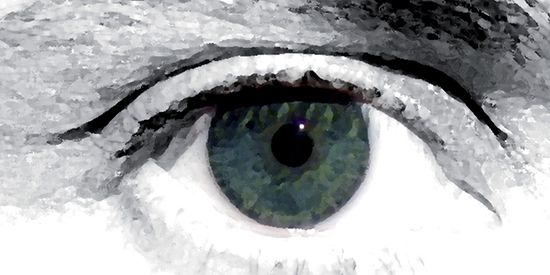Pupillenforschung
The pupil regulates the incidence of light on the retina and is exclusively controlled by the vegetative nervous system. Investigations and recordings of pupil behaviour not only provide objective information about functions of the retina and the visual pathway, but also about central nervous activation levels, emotion and cognition. Since 2012, the research group has received financial support from the Egon Schumacher Foundation, a private foundation without a commercial background. The aim of the funding is retina implant-related research, especially the development of biomarkers that can predict the individual implantation success or monitor further therapy approaches.
Contact
Management
frontend.sr-only_#{element.icon}: Prof. Dr. Bärbel Wilhelm
E-mail address: barbara.wilhelm@stz-eyetrial.de
frontend.sr-only_#{element.icon}: Prof. Dr. Helmut Wilhelm
E-mail address: helmut.wilhelm@med.uni-tuebingen.de
Forschungsprojekte/Studien
Research projects/studies
CNGA3
In this first study on the application of gene therapy to the eye in Germany (part of the RD-Cure Project http://www.rd-cure.de ; vector: rAAV.hCNGA3) and for CNGA3-related achromatopsia worldwide, colour stimulus pupillography is used as an objective marker of therapy efficacy. A disease-specific protocol based on this patient group was developed and included in the study protocol. The applicability of the method is shown in the clinical phase I/II study.
Publications:
- Lisowska J, Lisowski L, Kelbsch C, Maeda F, Richter P, Kohl S, Zobor D, Strasser T, Stingl K, Zrenner E, Peters T, Wilhelm H, Fischer MD, Wilhelm B; RD-CURE Consortium. Development of a Chromatic Pupillography Protocol for the First Gene Therapy Trial in Patients With CNGA3-Linked Achromatopsia. Invest Ophthalmol Vis Sci. 2017 Feb 1;58(2):1274-1282. doi: 10.1167/iovs.16-20505. PMID: 28241315.
- Fischer MD, Michalakis S, Wilhelm B, Zobor D, Muehlfriedel R, Kohl S, Weisschuh N, Ochakovski GA, Klein R, Schoen C, Sothilingam V, Garcia-Garrido M, Kuehlewein L, Kahle N, Werner A, Dauletbekov D, Paquet-Durand F, Tsang S, Martus P, Peters T, Seeliger M, Bartz-Schmidt KU, Ueffing M, Zrenner E, Biel M, Wissinger B. Safety and Vision Outcomes of Subretinal Gene Therapy Targeting Cone Photoreceptors in Achromatopsia: A Nonrandomized Controlled Trial. JAMA Ophthalmol. 2020 Jun 1;138(6):643-651. doi: 10.1001/jamaophthalmol.2020.1032. PMID: 32352493; PMCID: PMC7193523.
PDE6A
For a gene therapy study in PDE6A-related retinitis pigmentosa, we developed and tested a disease-specific protocol of colour stimulus pupillography with the participation of patients from an ongoing observational study on the natural course of the disease. This protocol is intended to be used in the phase I/II study as a biomarker for the efficacy of subretinal therapy with rAAV.hPDE6A.
Publication:
- Wilhelm B. Pupillographie in der Entwicklung von ophthalmologischen Gentherapien. Der Augenspiegel 02/2022: 39-39.
ELIOPASBA
Electrically and light-induced objective pupillary responses and simultaneous brain activity (ELIOPASBA)
The studies of the Eliopasba project focus on the measurement of pupillary reflex responses – elicited by transcorneal electric stimulation – in healthy volunteers and patients with retinitis pigmentosa as well as other hereditary retinal diseases. The aim is to identify particularly suitable stimulus parameters for the selective activation of different retinal nerve cells.
Publications:
- Kelbsch C, Jalligampala A, Strasser T, Richter P, Stingl K, Braun C, Rathbun DL, Zrenner E, Wilhelm H, Wilhelm B, Peters T, Stingl K. Phosphene perception and pupillary responses to sinusoidal electrostimulation - For an objective measurement of retinal function. Exp Eye Res. 2018 Nov;176:210-218. doi: 10.1016/j.exer.2018.07.010. Epub 2018 Jul 10. PMID: 30003883
- Jung R, Kelbsch C, Wilhelm H, Wilhelm B, Strasser T, Peters T, Kempf M, Kortüm F, Pohl L, Stingl K, Stingl K. Cell-specific electrical stimulation of human retinal neurons assessed by pupillary response dynamics in vivo. Exp Eye Res. 2022 Sep;222:109185. doi: 10.1016/j.exer.2022.109185. Epub 2022 Jul 16. PMID: 35850172.
- Jung R, Kempf M, Pohl L, Kortüm F, Reith M, Kelbsch C, Kohl S, Wilhelm H, Wilhelm B, Stingl K, Stingl K. Frequency-dependent retinal responsiveness to sinusoidal electrical stimulation in achromatopsia. Exp Eye Res. 2023 Jan;226:109349. doi: 10.1016/j.exer.2022.109349. Epub 2022 Dec 11. PMID: 36516904.
Chromatic Pupil Campimetry CPC in hereditary retinal degeneration and neuroophthalmological diseases
To assess the local function of the retina and the neuronal network, pupillary responses to specific coloured light stimuli are measured at different locations in the visual field. Measurements of patients with retinal or optic nerve diseases are compared with healthy individuals.
Publications:
- Stingl K, Peters T, Strasser T, Kelbsch C, Richter P, Wilhelm H, Wilhelm B. Pupillographic campimetry: an objective method to measure the visual field. Biomed Tech (Berl). 2018 Nov 27;63(6):729-734. doi: 10.1515/bmt-2017-0029.PMID: 29369809
- Kelbsch C, Stingl K, Kempf M, Strasser T, Jung R, Kuehlewein L, Wilhelm H, Peters T, Wilhelm B, Stingl K. Objective Measurement of Local Rod and Cone Function Using Gaze-Controlled Chromatic Pupil Campimetry in Healthy Subjects. Transl Vis Sci Technol. 2019 Nov 20;8(6):19. doi: 10.1167/tvst.8.6.19. PMID: 31788348; PMCID: PMC6871544.
- Stingl K, Kempf M, Bartz-Schmidt KU, Dimopoulos S, Reichel F, Jung R, Kelbsch C, Kohl S, Kortüm FC, Nasser F, Peters T, Wilhelm B, Wissinger B, Wozar F, Zrenner E, Fischer MD, Stingl K. Spatial and temporal resolution of the photoreceptors rescue dynamics after treatment with voretigene neparvovec. Br J Ophthalmol. 2022 Jun;106(6):831-838. doi: 10.1136/bjophthalmol-2020-318286. Epub 2021 Jan 20. PMID: 33472769; PMCID: PMC9132865.
- Kelbsch C, Stingl K, Jung R, Kempf M, Richter P, Strasser T, Peters T, Wilhelm B, Wilhelm H, Tonagel F. How lesions at different locations along the visual pathway influence pupillary reactions to chromatic stimuli. Graefes Arch Clin Exp Ophthalmol. 2022 May;260(5):1675-1685. doi: 10.1007/s00417-021-05513-5. Epub 2021 Dec 13. PMID: 34902059; PMCID: PMC9007757.
- Stingl K, Hoyng C, Kempf M, Kohl S, Jung R, Righetti G, Kühlewein L, Pohl L, Kortüm F, Kelbsch C, Wilhelm B, Peters T, Stingl K; SORAPRAZAN consortium. Evaluation of Local Rod and Cone Function in Stargardt Disease. Invest Ophthalmol Vis Sci. 2022 Mar 2;63(3):6. doi: 10.1167/iovs.63.3.6. PMID: 35262734; PMCID: PMC8934563.
- Kelbsch C, Lange J, Wilhelm H, Wilhelm B, Peters T, Kempf M, Kuehlewein L, Stingl K. Chromatic Pupil Campimetry Reveals Functional Defects in Exudative Age-Related Macular Degeneration with Differences Related to Disease Activity. Transl Vis Sci Technol. 2020 May 11;9(6):5. doi: 10.1167/tvst.9.6.5. PMID: 32821502; PMCID: PMC7409006.
- Sonntag A, Kelbsch C, Jung R, Wilhelm H, Strasser T, Peters T, Stingl K, Wilhelm B. Effect of central and peripheral cone- and rod-specific stimulation on the pupillary light reflex. Int Ophthalmol. 2022 May;42(5):1427-1436. doi: 10.1007/s10792-021-02132-1. Epub 2021 Nov 26. PMID: 34826023; PMCID: PMC9123028.
- Kelbsch C, Jendritza R, Strasser T, Tonagel F, Richter P, Jung R, Peters T, Wilhelm H, Wilhelm B, Stingl K. Central retina plays a decisive role in the suppression of pupillary escape. Graefes Arch Clin Exp Ophthalmol. 2023 Jan 16. doi: 10.1007/s00417-022-05959-1. Epub ahead of print. PMID: 36645454.
Establishment of a norm database for Chromatic Pupil Campimetry CPC
The aim of this project is to establish a large norm database of healthy adult control subjects for pupillary responses to specific stimulation protocols for the selective stimulation of cones or rods of the human retina. On the one hand, this analysis is important to investigate different parameters influencing the pupillary light reflex and, on the other hand, to be able to better classify the findings of patients and compare them with those of ophthalmologically healthy individuals of the same age.
IOP
We are examining the influence of coloured light on intraocular pressure in a study of healthy volunteers and patients with ocular hypertension and glaucoma.

Methodenentwicklung
Method development of the Tübingen Pupil Research Group
Pupillographic Sleepiness Test (PST)
With this long-term recording (11 minutes) of the pupil diameter under standardised conditions and quantitative analysis, the direct relation of the spontaneous pupillary oscillations in darkness with the wakefulness-controlling sympathetic locus coeruleus is used for an objective measurement of central nervous activation. The PST was developed by Prof. Barbara Wilhelm and Prof. Helmut Wilhelm in the 1990s, patented, brought to series production and introduced into the routine of sleep medicine and sleep research. We continuously conduct or support scientific studies with the PST.
Publication:
- von Lukowicz H, Poets CF, Peters T, Wilhelm B, Schlarb A, Urschitz MS. Validity of the Pupillographic Sleepiness Test for the diagnosis of daytime sleepiness in children and adolescents and its relationship to sleepiness-associated outcomes. Sleep Med. 2021 Jul;83:145-150. doi: 10.1016/j.sleep.2021.04.030. Epub 2021 Apr 28. PMID: 34015717.
Chromatic Pupil Campimetry (CPC)
Light stimuli are presented on a screen at different locations in the visual field and the pupil diameter is continuously recorded by means of an infrared video camera. By selecting the size, intensity and colour of the light stimuli as well as different adaptation states of the retina, different cells of the retina can be activated. This allows an assertion about the local function of cones and rods of the retina, which is also used in the evaluation of novel therapy concepts. Both the hardware and the software of the campimetry prototype are developments of our research group. The device is used in several scientific studies at our clinic.
For publications, see Chromatic Pupil Campimetry CPC in hereditary retinal degeneration and neuroophthalmological diseases.
Publications:
For publications, see Chromatic Pupil Campimetry CPC in hereditary retinal degeneration and neuroophthalmological diseases
Colour pupillography
Based on the AmTech pupillograph, we have added a full-field stimulator and an external stimulation unit so that large-area stimulation of the retina with coloured light of narrow wavelength bandwidth is possible.
Publications on full-field Colour pupillography:
- Kelbsch CB, Maeda F, Strasser T, Peters TM, Wilhelm BJC, Wilhelm HM. Color Pupillography in Dorsal Midbrain Syndrome. J Neuroophthalmol. 2017 Sep;37(3):247-252. doi:10.1097/WNO.0000000000000527. PMID: 28708670
- Kelbsch C, Maeda F, Lisowska J, Lisowski L, Strasser T, Stingl K, Wilhelm B, Wilhelm H, Peters T. Analysis of retinal function using chromatic pupillography in retinitis pigmentosa and the relationship to electrically evoked phosphene thresholds. Acta Ophthalmol. 2017 Jun;95(4):e261-e269. doi: 10.1111/aos.13259. Epub 2016 Sep 29. PMID: 27683070.
- Maeda F, Kelbsch C, Straßer T, Skorkovská K, Peters T, Wilhelm B, Wilhelm H. Chromatic pupillography in hemianopia patients with homonymous visual field defects. Graefes Arch Clin Exp Ophthalmol. 2017 Sep;255(9):1837-1842. doi: 10.1007/s00417-017-3721-y. Epub 2017 Jun 30. PMID: 28687871
- Kelbsch C, Maeda F, Strasser T, Blumenstock G, Wilhelm B, Wilhelm H, Peters T. Pupillary responses driven by ipRGCs and classical photoreceptors are impaired in glaucoma. Graefes Arch Clin Exp Ophthalmol. 2016 Jul;254(7):1361-70. doi: 10.1007/s00417-016-3351-9. Epub 2016 Apr 21. PMID: 27099948.
- Richter P, Wilhelm H, Peters T, Luedtke H, Kurtenbach A, Jaegle H, Wilhelm B. The diagnostic accuracy of chromatic pupillary light responses in diseases of the outer and inner retina. Graefes Arch Clin Exp Ophthalmol. 2017 Mar;255(3):519-527. doi: 10.1007/s00417-016-3496-6. Epub 2016 Oct 26. PMID: 27785596.
- Stingl KT, Kuehlewein L, Weisschuh N, Biskup S, Cremers FPM, Khan MI, Kelbsch C, Peters T, Ueffing M, Wilhelm B, Zrenner E, Stingl K. Chromatic Full-Field Stimulus Threshold and Pupillography as Functional Markers for Late-Stage, Early-Onset Retinitis Pigmentosa Caused by CRB1 Mutations. Transl Vis Sci Technol. 2019 Dec 20;8(6):45. doi: 10.1167/tvst.8.6.45. PMID: 31879567; PMCID: PMC6927735.
SWIFT
Automated swinging-flashlight test using binocular pupillography and exact quantitative analysis.
Publikationen
Review publications on pupil examination / pupillography by our group
- Kelbsch C, Strasser T, Chen Y, Feigl B, Gamlin PD, Kardon R, Peters T, Roecklein KA, Steinhauer SR, Szabadi E, Zele AJ, Wilhelm H, Wilhelm BJ. Standards in Pupillography. Front Neurol. 2019 Feb 22;10:129. doi: 10.3389/fneur.2019.00129. Erratum in: Front Neurol. 2019 Mar 27;10:371. PMID: 30853933; PMCID: PMC6395400.
- Wilhelm H, Kelbsch C. Efferente Pupillenstörungen: Anisokorie und gestörte Lichtreaktion [Efferent pupillary defects: Anisocoria and impaired light reaction]. Ophthalmologe. 2017 Jan;114(1):79-90. German. doi: 10.1007/s00347-016-0420-8. PMID: 28070646.
Siehe auch
Siehe auch
Certificates and Associations

Focus: Top National Hospital 2025

Stern: Germany's Outstanding Employers in Nursing 24/25

Quality partnership with the PKV

Family as a success factor

Pension provision for the public sector





